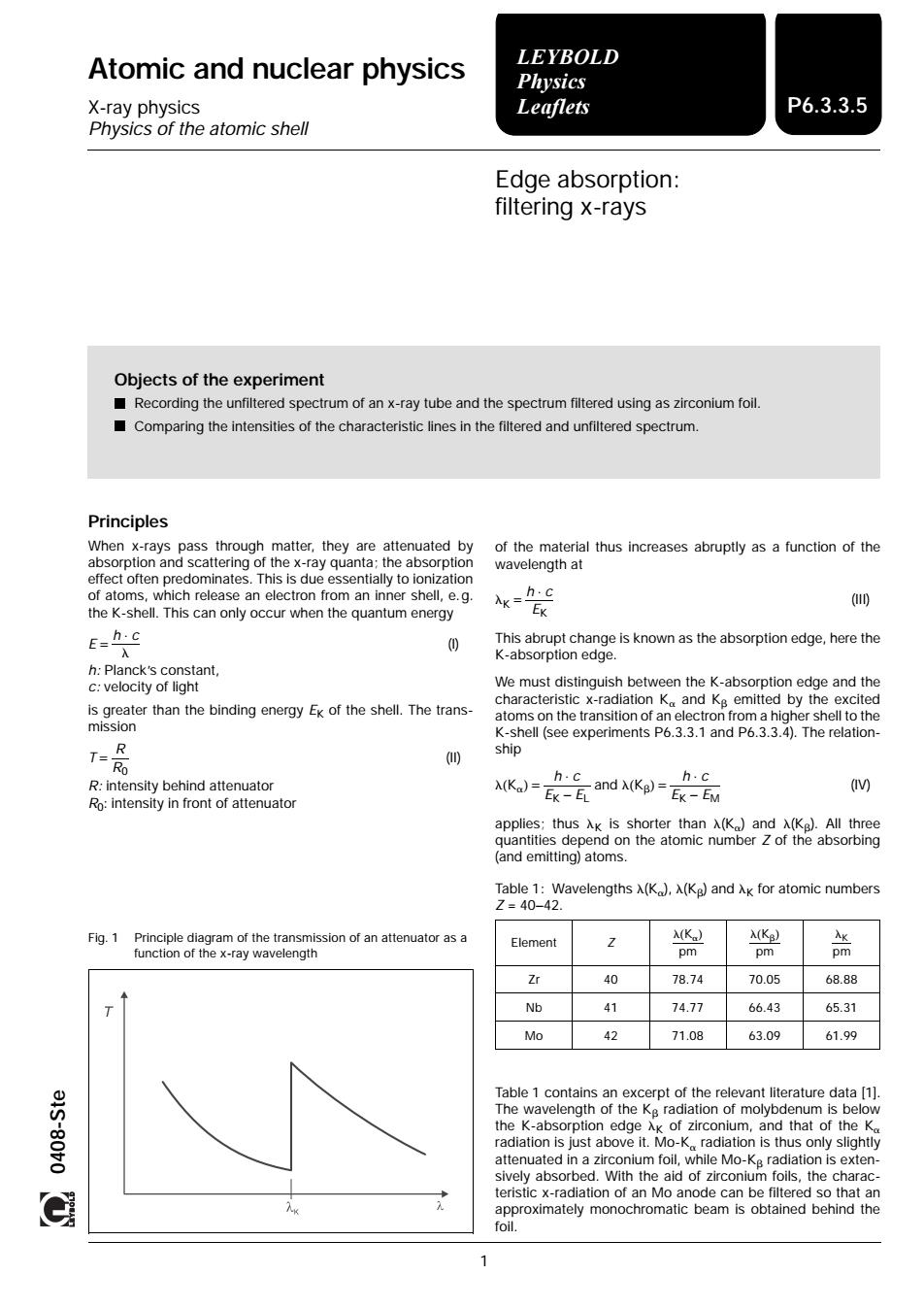正在加载图片...

Atomic and nuclear physics LEYBOLD Physics X-ray physics Leaflets P6.3.3.5 Physics of the atomic shell Edge absorption: filtering x-rays Objects of the experiment Recording the unfiltered spectrum of an x-ray tube and the spectrum filtered using as zirconium foil. Comparing the intensities of the characteristic lines in the filtered and unfiltered spectrum. Principles When x-rays pass through matter,they are attenuated by of the material thus increases abruptly as a function of the absorption and scattering of the x-ray quanta;the absorption wavelength at effect often predominates.This is due essentially to ionization of atoms,which release an electron from an inner shell,e.g. Ak=h.c (0 the K-shell.This can only occur when the quantum energy E=h.c 0 This abrupt change is known as the absorption edge,here the K-absorption edge. h:Planck's constant, c:velocity of light We must distinguish between the K-absorption edge and the characteristic x-radiation K and Kg emitted by the excited is greater than the binding energy Ek of the shell.The trans- atoms on the transition of an electron from a higher shell to the mission K-shell(see experiments P6.3.3.1 and P6.3.3.4).The relation- T入R ship o h.c R:intensity behind attenuator λ(Ka)= h·c Ro:intensity in front of attenuator Ek-EL andλKp=EK-w applies:thus Ak is shorter than A(K)and A(Kg).All three quantities depend on the atomic number Z of the absorbing (and emitting)atoms. Table1:Wavelengthsλ(K,),λ(Kg)andλ<for atomic numbers Z=40-42. Fig.1 Principle diagram of the transmission of an attenuator as a Element (K.) X(KB) K function of the x-ray wavelength pm pm pm Zr 40 78.74 70.05 68.88 Nb A1 74.77 66.43 65.31 Mo 42 71.08 63.09 61.99 Table 1 contains an excerpt of the relevant literature data [1]. P11.8060 The wavelength of the Kg radiation of molybdenum is below the K-absorption edge Ak of zirconium,and that of the K radiation is just above it.Mo-K radiation is thus only slightly attenuated in a zirconium foil,while Mo-Ke radiation is exten- sively absorbed.With the aid of zirconium foils,the charac- teristic x-radiation of an Mo anode can be filtered so that an approximately monochromatic beam is obtained behind the foil.Fig. 1 Principle diagram of the transmission of an attenuator as a function of the x-ray wavelength Atomic and nuclear physics X-ray physics Physics of the atomic shell LEYBOLD Physics Leaflets Edge absorption: filtering x-rays Objects of the experiment Recording the unfiltered spectrum of an x-ray tube and the spectrum filtered using as zirconium foil. Comparing the intensities of the characteristic lines in the filtered and unfiltered spectrum. Principles When x-rays pass through matter, they are attenuated by absorption and scattering of the x-ray quanta; the absorption effect often predominates. This is due essentially to ionization of atoms, which release an electron from an inner shell, e.g. the K-shell. This can only occur when the quantum energy E = h ⋅ c l (I) h: Planck’s constant, c: velocity of light is greater than the binding energy EK of the shell. The transmission T = R R0 (II) R: intensity behind attenuator R0: intensity in front of attenuator of the material thus increases abruptly as a function of the wavelength at lK = h ⋅ c EK (III) This abrupt change is known as the absorption edge, here the K-absorption edge. We must distinguish between the K-absorption edge and the characteristic x-radiation Ka and Kb emitted by the excited atoms on the transition of an electron from a higher shell to the K-shell (see experiments P6.3.3.1 and P6.3.3.4). The relationship l(Ka) = h ⋅ c EK − EL and l(Kb) = h ⋅ c EK − EM (IV) applies; thus lK is shorter than l(Ka) and l(Kb). All three quantities depend on the atomic number Z of the absorbing (and emitting) atoms. Table 1 contains an excerpt of the relevant literature data [1]. The wavelength of the Kb radiation of molybdenum is below the K-absorption edge lK of zirconium, and that of the Ka radiation is just above it. Mo-Ka radiation is thus only slightly attenuated in a zirconium foil, while Mo-Kb radiation is extensively absorbed. With the aid of zirconium foils, the characteristic x-radiation of an Mo anode can be filtered so that an approximately monochromatic beam is obtained behind the foil. Table 1: Wavelengths l(Ka), l(Kb) and lK for atomic numbers Z = 40−42. Element Z l(Ka) pm l(Kb) pm lK pm Zr 40 78.74 70.05 68.88 Nb 41 74.77 66.43 65.31 Mo 42 71.08 63.09 61.99 P6.3.3.5 0408-Ste 1